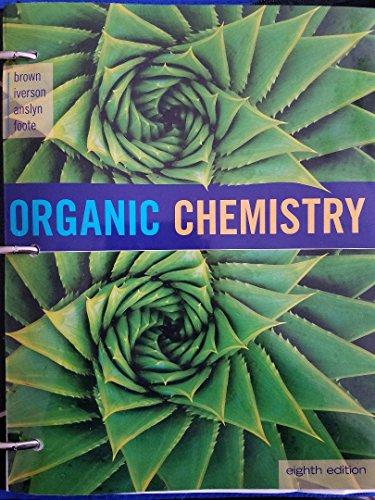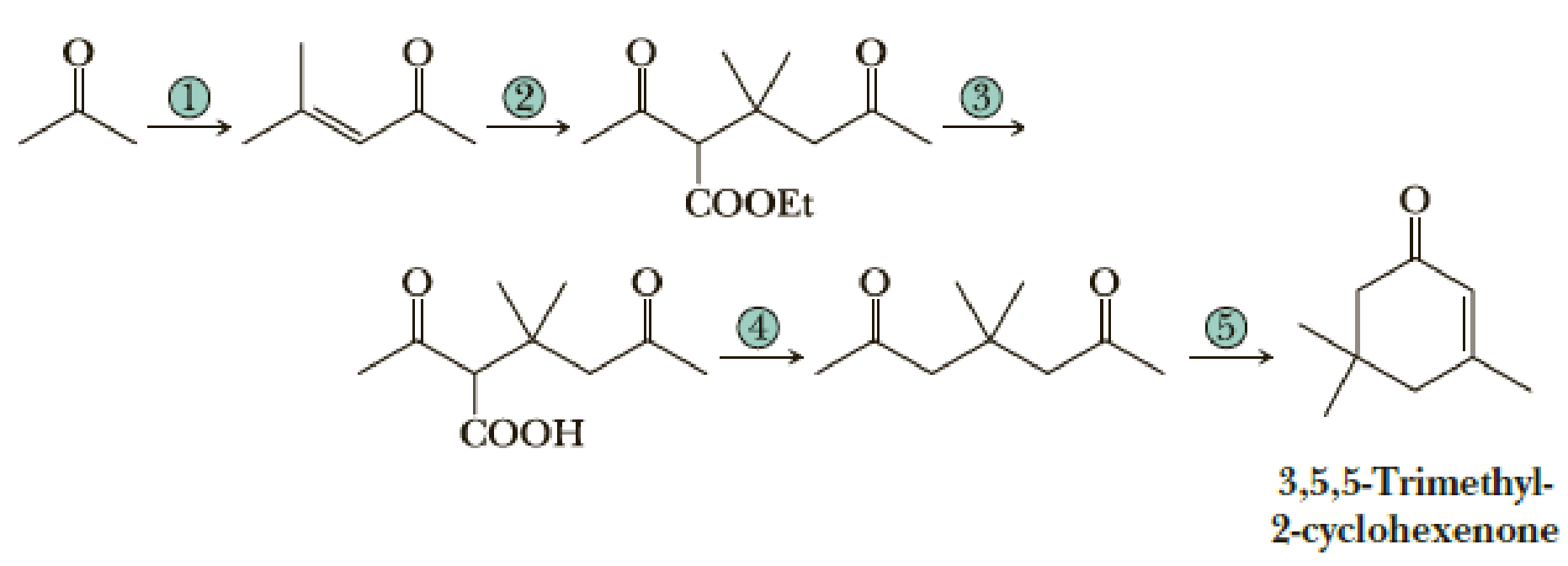
Organic Chemistry, Loose-leaf Version
8th Edition
ISBN: 9781305865549
Author: William H. Brown, Brent L. Iverson, Eric Anslyn, Christopher S. Foote
Publisher: Cengage Learning
expand_more
expand_more
format_list_bulleted
Concept explainers
Textbook Question
Chapter 19, Problem 19.56P
The compound 3,5,5-trimethyl-2-cyclohexenone can be synthesized using acetone and ethyl acetoacetate as sources of carbon atoms. New carbon-carbon bonds in this synthesis are formed by a combination of aldol reactions and Michael reactions. Show reagents and conditions by which this synthesis might be accomplished.

Expert Solution & Answer
Trending nowThis is a popular solution!

Students have asked these similar questions
help
Aldehydes and ketones undergo acid-catalyzed reaction with alcohols to yield hemiacetals, compounds that have one alcohol-like oxygen
and one ether-like oxygen bonded to the same carbon. Further reaction of a hemiacetal with alcohol then yields an acetal, a compound that
has two ether-like oxygens bonded to the same carbon.
Show the structure of the acetal that you would obtain by reaction of acetophenone with 2-propanol.
•
You do not have to consider stereochemistry.
•
You do not have to explicitly draw H atoms.
Do not include lone pairs in your answer. They will not be considered in the grading.
?
The following are intermediate products in the stepwise synthesis of compound 1 from benzene. Give the correct sequence of reactions with the appropriate reagents that will lead to the correct intermediate products and final product.
Chapter 19 Solutions
Organic Chemistry, Loose-leaf Version
Ch. 19.2 - Prob. 19.1PCh. 19.2 - Prob. 19.2PCh. 19.2 - Prob. 19.3PCh. 19.3 - Prob. 19.4PCh. 19.3 - Prob. 19.5PCh. 19.3 - Prob. 19.6PCh. 19.5 - Prob. 19.7PCh. 19.5 - Prob. 19.8PCh. 19.5 - Prob. 19.9PCh. 19.6 - Prob. 19.10P
Ch. 19.6 - Prob. 19.11PCh. 19.7 - Prob. 19.12PCh. 19.8 - Prob. 19.13PCh. 19.8 - Prob. 19.14PCh. 19.8 - Prob. 19.15PCh. 19.8 - Prob. 19.16PCh. 19.9 - Prob. 19.17PCh. 19.9 - Prob. AQCh. 19.9 - Prob. BQCh. 19.9 - Prob. CQCh. 19.9 - Prob. DQCh. 19.9 - Prob. EQCh. 19.9 - Prob. FQCh. 19.9 - Prob. GQCh. 19.9 - Intermediate G in Synthesis III is produced as a...Ch. 19.9 - Prob. IQCh. 19.9 - Prob. JQCh. 19 - Prob. 19.18PCh. 19 - Prob. 19.19PCh. 19 - Prob. 19.20PCh. 19 - Prob. 19.21PCh. 19 - Prob. 19.22PCh. 19 - Prob. 19.23PCh. 19 - Cyclohexene can be converted to...Ch. 19 - Prob. 19.25PCh. 19 - Prob. 19.26PCh. 19 - Prob. 19.27PCh. 19 - Prob. 19.28PCh. 19 - Prob. 19.29PCh. 19 - Prob. 19.30PCh. 19 - Draw structural formulas for the -ketoesters...Ch. 19 - Prob. 19.32PCh. 19 - Prob. 19.33PCh. 19 - Propose a synthesis for each ketone, using as one...Ch. 19 - Prob. 19.35PCh. 19 - Claisen condensation between diethyl phthalate and...Ch. 19 - Prob. 19.37PCh. 19 - Prob. 19.38PCh. 19 - Prob. 19.39PCh. 19 - Enamines normally react with methyl iodide to give...Ch. 19 - Prob. 19.41PCh. 19 - Prob. 19.42PCh. 19 - Prob. 19.43PCh. 19 - Prob. 19.44PCh. 19 - Prob. 19.45PCh. 19 - Prob. 19.46PCh. 19 - Prob. 19.47PCh. 19 - Prob. 19.48PCh. 19 - Prob. 19.49PCh. 19 - Prob. 19.50PCh. 19 - Prob. 19.51PCh. 19 - Prob. 19.52PCh. 19 - Show experimental conditions by which to carry out...Ch. 19 - Prob. 19.55PCh. 19 - The compound 3,5,5-trimethyl-2-cyclohexenone can...Ch. 19 - Prob. 19.57PCh. 19 - Prob. 19.58PCh. 19 - The widely used anticoagulant warfarin (see...Ch. 19 - Following is a retrosynthetic analysis for an...Ch. 19 - Following are the steps in one of the several...Ch. 19 - Prob. 19.62PCh. 19 - Prob. 19.63PCh. 19 - Prob. 19.65PCh. 19 - Prob. 19.67PCh. 19 - Prob. 19.68PCh. 19 - Prob. 19.69PCh. 19 - In Problem 7.28, we saw this two-step sequence in...Ch. 19 - Using your reaction roadmaps as a guide, show how...Ch. 19 - Using your reaction roadmaps as a guide, show how...Ch. 19 - Using your reaction roadmaps as a guide, show how...Ch. 19 - Using your reaction roadmaps as a guide, show how...Ch. 19 - Using your reaction roadmaps as a guide, show how...Ch. 19 - Prob. 19.79PCh. 19 - Prob. 19.80PCh. 19 - Prob. 19.81PCh. 19 - The following molecule undergoes an intramolecular...
Additional Science Textbook Solutions
Find more solutions based on key concepts
Choose the best answer to each of the following. Explain your reasoning. If Earth were twice as far as it actua...
Cosmic Perspective Fundamentals
Define histology.
Fundamentals of Anatomy & Physiology (11th Edition)
Why do scientists think that all forms of life on earth have a common origin?
Genetics: From Genes to Genomes
Give the IUPAC name for each compound.
Organic Chemistry
11. In the early 1800s, French naturalist Jean Baptiste Lamarck suggested that the best explanation for the rel...
Campbell Biology: Concepts & Connections (9th Edition)
Knowledge Booster
Learn more about
Need a deep-dive on the concept behind this application? Look no further. Learn more about this topic, chemistry and related others by exploring similar questions and additional content below.Similar questions
- Nonconjugated , -unsaturated ketones, such as 3-cyclohexenone, are in an acid-catalyzed equilibrium with their conjugated , -unsaturated isomers. Propose a mechanism for this isomerization.arrow_forwardClaisen condensation between diethyl phthalate and ethyl acetate followed by saponification, acidification, and decarboxylation forms a diketone, C9H6O2. Propose structural formulas for compounds A and B and the diketone.arrow_forwardWhat reactions and reagents can be used to make phenol from benzene if electrophilic aromatic substitution reactions are excluded and benzene is the only source of carbon?arrow_forward
- Ph3P-CHCH3 H₂C H3C Aldehydes and ketones are converted into alkenes by means of a direct nucleophilic addition called the Wittig reaction. In the reaction, a triphenylphosphorine ylide, also called a phosphorane, adds to an aldehyde/ketone to give a four-membered cyclic intermediate called an oxaphosphetane. The oxaphosphetane is not isolated but instead spontaneously decomposes to release triphenylphosphine oxide and an alkene. CH3 00 + The ylide is formed by reaction of triphenylphosphine, a good nucleophile, with a primary alkyl halide in an SN2 reaction, followed by deprotonation of the carbon with a strong base, such as butyllithium. The carbonyl carbon and the carbon originally bonded to the halogen become the two carbons with the double bond in the product alkene X m CH3 The real value of the Wittig reaction lies in its ability to yield an alkene of predictable structure, as the C=C bond is precisely where the C=O bond was in the reactant and no isomers (other than E/Z isomers)…arrow_forwardHow would you perform an experiment to produce cyclohexanol from cyclohexene? Describe in detail the reagents and glassware you would use including approximate amounts and concentrations of reagents. What steps would be needed to purify the cyclohexanol from the other reagents used in the reaction?arrow_forwardCH3 Ph3P-CHCH3 H3C H3C Aldehydes and ketones are converted into alkenes by means of a direct nucleophilic addition called the Wittig reaction. In the reaction, a triphenylphosphorine ylide, also called a phosphorane, adds to an aldehyde/ketone to give a four-membered cyclic intermediate called an oxaphosphetane. The oxaphosphetane is not isolated but instead spontaneously decomposes to release triphenylphosphine oxide and an alkene. Ph3P-CHCH3 H3C The ylide is formed by reaction of triphenylphosphine, a good nucleophile, with a primary alkyl halide in an S 2 reaction, followed by deprotonation of the carbon with a strong base, such as butyllithium. The carbonyl carbon and the carbon originally bonded to the halogen become the two carbons with the double bond in the product alkene :0: CH3 Com The real value of the Wittig reaction lies in its ability to yield an alkene of predictable structure, as the C-C bond is precisely where the C=O bond was in the reactant and no isomers (other than…arrow_forward
- H3C OH OH H+ CH3 Esters can be synthesized by an acid-catalyzed nucleophilic acyl substitution between an alcohol and a carboxylic acid; this process is called the Fischer esterification reaction. Because the alcohol oxygen is a poor nucleophile, the carbonyl carbon is made a better electrophile by protonation of the carbonyl oxygen. The steps of the synthesis are all reversible. The reaction is generally driven to completion by using an excess of the liquid alcohol as a solvent, or by distilling off the product as it forms. Draw curved arrows to show the movement of electrons in this step of the mechanism. Arrow-pushing Instructions CIX 10-4 H₂O CH3 H₂O CH3arrow_forwardWhich of the following sequences of reactions would convert toluene to 2-bromo-4-cyanotoluene? Bromination, nitration, reduction, diazotization, reaction with cyanide anion Bromination, nitration, diazotization, reduction , reaction with cyanide anion Nitration, bromination, reduction, diazotization, reaction with cyanide anion Nitration, bromination, diazotization, reduction, reaction with cyanide anionarrow_forwardFor each of the transformations given below, draw the structures of the named starting material, products and possible intermediates. State the necessary reagents and conditions in the reaction scheme. More than one step may be required. cyclohexylmethanol ethenylbenzene pent-1-ene 2-methylpentan-3-ol cyclohexanecarbaldehyde acetophenone 2-methylpenta-2-amine propanoic acid + propanone a) b)arrow_forward
- The following substances can be prepared by a nucleophilic addition reaction between an aldehyde or ketoneand a nucleophile. Identify the reactants from which they were prepared. If the substance is an acetal, identifythe carbonyl compound and the alcohol; if it is an imine or enamine, identify the carbonyl compound and theamine. You do not have to consider stereochemistry. In cases where there is more than one answer, just giveone. Use Grignard reagents when an organometallic reagent is required. Draw the Grignard reagent as acovalent magnesium bromide.arrow_forwardWhat are the three alkenes formed in the acid-catalyzed dehydration of 2-pentanol? Propose the mechanism of their formation.arrow_forwardH NH₂ ཡིནྣཾ ༥ ཨ ཨནྡྷ༥ ༠ ཨི་ཝཱ, ཙ ཨ་ར༩ H NH3+ the acidity of the amine ion drives the reaction to shift toward the conjugate base of the carboxylic acid product. the resulting carboxylic acid ion is a weaker base than an acetate ion. O aldehydes are more reactive toward nucleophiles than ketones. Onucleophilic attack occurs preferentially at the less hindered carbon of the formyl group.arrow_forward
arrow_back_ios
SEE MORE QUESTIONS
arrow_forward_ios
Recommended textbooks for you
 Organic ChemistryChemistryISBN:9781305580350Author:William H. Brown, Brent L. Iverson, Eric Anslyn, Christopher S. FootePublisher:Cengage Learning
Organic ChemistryChemistryISBN:9781305580350Author:William H. Brown, Brent L. Iverson, Eric Anslyn, Christopher S. FootePublisher:Cengage Learning
 Organic Chemistry: A Guided InquiryChemistryISBN:9780618974122Author:Andrei StraumanisPublisher:Cengage Learning
Organic Chemistry: A Guided InquiryChemistryISBN:9780618974122Author:Andrei StraumanisPublisher:Cengage Learning

Organic Chemistry
Chemistry
ISBN:9781305580350
Author:William H. Brown, Brent L. Iverson, Eric Anslyn, Christopher S. Foote
Publisher:Cengage Learning


Organic Chemistry: A Guided Inquiry
Chemistry
ISBN:9780618974122
Author:Andrei Straumanis
Publisher:Cengage Learning
Coenzymes and cofactors; Author: CH15 SWAYAM Prabha IIT Madras;https://www.youtube.com/watch?v=bubY2Nm7hVM;License: Standard YouTube License, CC-BY
Aromaticity and Huckel's Rule; Author: Professor Dave Explains;https://www.youtube.com/watch?v=7-BguH4_WBQ;License: Standard Youtube License